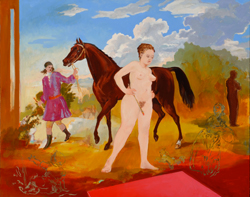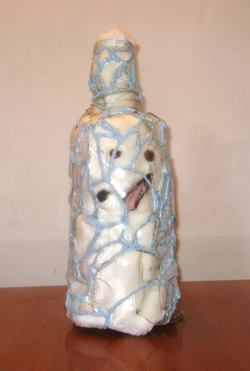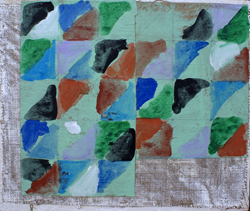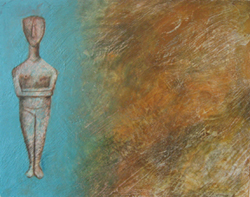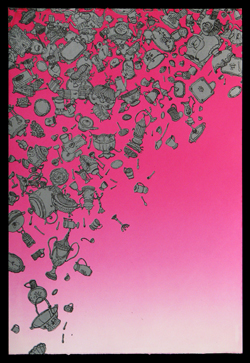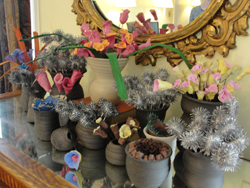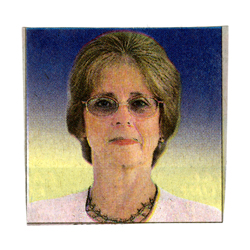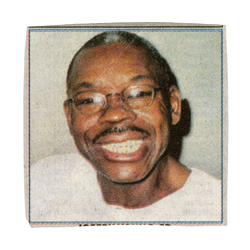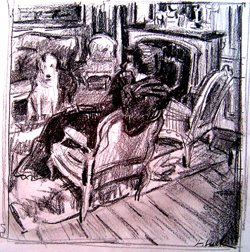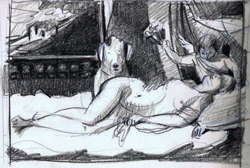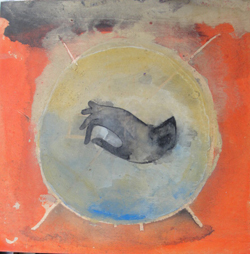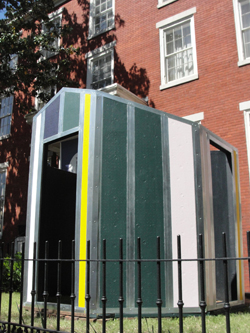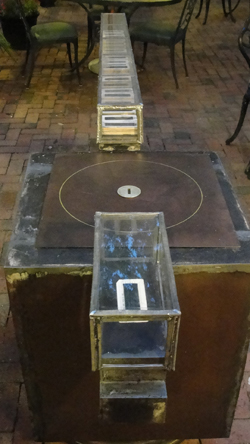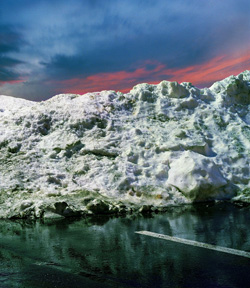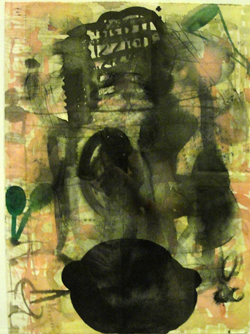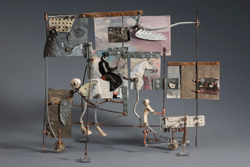Satellite Exhibition
Reflecting and Collecting
May 1 — August 25, 2010
1708 Gallery celebrates the reopening of the Virginia Museum of Fine Arts in a Satellite Exhibition at The Linden Row Inn.
This multi-media exhibition celebrates the reopening of the Virginia Museum of Fine Arts and the role it's art collection can play as a muse in the creative process. Curated by Amie Oliver, Reflecting and Collecting features work by 19 artists who live or have lived in Virginia. Each artist has created new work in response to artwork in a VMFA permanent collection. The list below includes each artist featured in the exhibition, their website (if available), the media they have chosen to work with, the specific VMFA artwork they were inspired by and a statement by the artist describing that inspiration.
Please visit the links below for more information:
www.lindenrowinn.com
www.vmfa.state.va.us
http://amieoliver.net
See photos of the artwork at Linden Row Inn HERE.
Exhibiting Artists
Ruth Bolduan (painting)
A Bay Horse Got By the Leeds Arabian, 1715, John Wootton, The Paul Mellon Collection
I am drawn to history, horses, and people. Eighteenth century paintings portray a time when beauty of form and phrase was linked to intellect, desire, fashion, and taste. A period of glitter and doom, the 18th century resonates in our lives today. John Wootton’s magnificent painting of a horse and groom in the landscape reminds me of why I make paintings.
Sally Bowring (painting)
Egyptian Garden, Ancient Art Collection
“Green Garden” references the plan of Sennufer’s Garden, the most famous illustration of an Egyptian garden and the world’s oldest accurate plan of a garden. I became interested in this particular image after working with the “garden” as subject matter for several years. The previous garden paintings were about domestic behavior of planning, arranging and enforcing order or constant chaos- both the garden and home-life. Prior to these paintings the physical format of my work was putting small paintings together to make one large one. This semi-grid structure has always intrigued me and once again I found an ordered format to hold my chaos.
David Choi (sculpture)
Portrait of Mrs. French's White Lap Dog, George Stubbs, The Paul Mellon Collection
The useless is beautiful because it is less real than the useful that extends and prolongs itself, while the marvelously futile, the gloriously infinitesimal, remains where it is- doesn’t stop being what it is, lives free and independent.
Fernando Pessoa
In my work, I try to emphasize the importance of play and the freeness of frivolity.
Without direct or strictly guided ambitions, creation is to exploit the baseness of materials in a process that liberates and allows them to nobly mutate and transform into something more fantastical than the imagination holds.
The transformation of useless materials is an alchemical process of creation. When something is declared useless, it has more strive to be, making it non-complacent in the endless search for definition and meaning.
One should not have expectations or a purpose in the act of true creation. I am most interested in a story-less narrative that in turn, is endless in conclusion. My art is a mythology that has no era and has yet to be unturned.
Sonya Clark (mixed media)
A Ride for Liberty- The Fugitive Slaves, 1862, Eastman Johnson (American, 1824-1906), Paul Mellon Collection
Cloth speaks and so does hair. Like textiles, hairstyles express politics, heritage, and culture. This piece juxtaposes the two. The traditional African American Hairstyling techniques of cornrows and Bantu knots become the stars and stripes of the American flag against a backdrop of the Confederate flag. And so these complicated histories coincide. This work was inspired by Eastman Johnson's 1862 painting, “A Ride for Liberty-The Fugitive Slaves”. Johnson was one of very few American painters in the time period to depict this complicated history.
Don Crow (mixed media)
Wall Drawing #541, Sol LeWitt, Sydney and Francis Lewis Collection
Sol Le Witt’s geometric paintings are an inspiration for the directness of the imagery, the lack of artifice and the sentiment that the - merely visual- is enough to create a significant aesthetic experience.
Diana Detamore (drawing)
Cycladic Female Figure, ca 2400 BC, Ancient Art Collection
It is not unusual to find me wandering the galleries of the Virginia Museum in the middle of the day. I was introduced to the wonders and mysteries of spending time in art museums at an early age. My high school art teacher frequently took us to visit his "girlfriend" Rogier van der Weyden's “Portrait of a Lady”, c. 1460, at the National Gallery of Art in Washington DC. I found the museum to be a place for introspection, intellectual curiosity, creative inspiration, as well as a respite from my everyday travails.
The Cycladic figure depicted in my painting is believed to be a fertility symbol. and evocative of the power of the feminine, the wisdom and mystery of the universe's cyclical regeneration. She has a timeless quality. It is not coincidence that I stumbled upon her in my museum wanderings for these evocative themes continue to intrigue me.
Aimee Joyaux (sculpture)
Beaded Crown, 19-20C, Yoruba culture, African art collection
I am drawn to and inspired by African art in general and this Yoruba headpiece specifically because of the patterns and rich surfaces. Whether embellished as a form of decoration or as the result of function, much of this work seems like a direct conduit of power and spirituality. These totems are my attempt to embody these influences by creating objects of enough grandeur to wear one of those Yoruba beaded crowns. I was challenged here to adorn the figure, not something I deal with often as an artist. I’m also playing with a postmodern pastiche of cultural, aesthetic, and religious references. I see my background of Catholicism, Hawaiian deities, and the totems of the Pacific Northwest, places I have lived, and more recent references from Petersburg and Richmond, a history I am learning, meld into this visual exploration.
I have named my figures St. Benedict the Black and St. Lucy. Through them I have come closer to my past and my present.
Andrew Kozlowski (printmaking)
Soup Tureen, Cover and Liner, 1736, PAUL DE LAMERIE (English , 1688 - 1751), From the English Silver collection
Perhaps it was the time I spent working in a museum that helped cultivate my interest in those objects that share space with masterpieces, but are often relegated to the status of supporting cast. Objects of the decorative art departments feature the unique characteristics of at times being, functional, ornamental, grand, or ceremonial, often sharing one or more of these characteristics. I see these objects not in terms of the allegories depicted on them or periods that they were crafted in, but as a whole, a representation of class distinctions, privilege, and extravagance. While those works of English Silver that reside in the safe confines of the museum are representative of the pinnacle of craftsmanship and certainly have their provenance, I imagine many others fated to be the spoils of wars, the casualties of revolutions, sold as antiques for medical care, or becoming the victims of breaking and entering. Here the objects of lesser fortunes glimmer while they cascade down against a brilliant sky, a collapse forcing their owners and commissioners to part ways prematurely due to an unexpected exchange of currency or power. Throughout their history objects such as these are stolen, surrendered, plundered, left behind, buried, and occasionally melted down, but never are they discarded.
Karen Kincaid
The Abundance of Nature, Severin Roesen, (American, born Germany , ca. 1815 - ca. 1872), ca. 1855, Oil on canvas, 56.125 x 40.125 in.
I love looking at pictures of flowers especially the Dutch tulip paintings of the 15th century. This piece is similar but different in a quirky way.
The lushness of the subject material as well as the application of the paint look surreal.
Michael Lease (photography)
Funerary Image of Woman, AD late 200s early 300s, beeswax and pigment on wood panel, 13x8.25". VMFA #55.4, Roman, Egypt
Mazeppa Held by a Jockey, painted late spring, 1835, Edward Troye (American, 1808-1874), Oil on canvas, 21-1/2”H x 27”W Mellon Collection 86.77
“Reading Blues” is a collection of obituary photographs of individuals from Richmond, VA and Washington, DC newspapers. The color, and black and white photographs are clipped from the papers' obituary sections, scanned, and outputted larger than their original size. Enlarging the images emphasizes the now antiquated beauty of the newspapers' half-tone printing process.
In the pictures, these people smile and gaze at the camera --often framed by idyllic backgrounds-- locked forever in the moment the image was made. A daily perusal of the obits affords me the uncommon and unlikely opportunity to look into the eyes of these strangers and wonder in which ways we are the same.
I read, snip, and collect not only to know, but to love.
Lauri Luck (drawing)
The Golden Chair, Edouard Vuillard (French, 1868-1940), Paul Mellon Collection
>Venus and Cupid, Artemisia Gentileschi (Italian, 1593-1652/3), European Art Collection
All knowledge, the totality of all questions and answers, is contained in the dog
Franz Kafka
When I first looked through the Virginia Museum’s collection to select my reference images for the “Reflecting and Collecting” exhibition I was expecting to choose images containing animals. Animal imagery, especially that of dogs - which I prefer to paint and draw - brings a unique spirit to the work I do and I am continually inspired by the immediacy of their animal presence, their enviable lack of self-consciousness and their boundless joy of spirit. So I was surprised by my strong response to Artemisia Gentileschi’s “Venus and Cupid” and Edouard Vuillard’s “The Golden Chair” which contain no animals at all. What intrigued me though was the overwhelming sense of waiting in these paintings, that dreariness of being “on hold” is something I personally abhor. The women depicted appear so serious, almost suffocated, in their heavily draped and darkened rooms, their languorous and depressed repose turned inward with endless review.
My first thought was “Yikes!” - these gals need to lighten up – they need a dog. So I lent my dog Dot who gazes out calm and steady, taking on the role of “straight man” to the all the melodrama of these women’s lives – lending a little humor to the atmosphere of ennui, her peanut shaped mug daring you not to smile.
Jeff Majer (painting)
Lemons May 16 1984, DONALD SULTAN (American , born 1951), 1984
When choosing a piece I tried to think of one that made a large impact on me from memory. It ended up biting me in the back side because I remembered it too well and felt like I was repeating what I liked about it. I had to try to take some things from it and toss away those things that were not me.
Amie Oliver (painting)
Sacred Diagram of the Universe, (Mandala of Hevajra), Tibetan, 1400-1600, Opaque watercolor on cloth, 32 by 28 1/2 inches
Wheel of Life, Tibetan, late 18th-early 19th century, Opaque watercolor on cloth, 54 by 42 inches
An artist statement I drafted years ago has proven to be relevant to my work in general, but in particular to my current work, The Dharma Diaries. My experiences observing Tibetan Monks work at the VMFA and enjoying the Himalayan Collection preceded my recent project in Tibet.
Primary to my aesthetic is an experimentation with media. The power of symbols, objects and a vocabulary of human form are the language of this dialogue. Timeless imagery and modern iconography motivate me to create art that embraces conflict, revision, passion, reason, beauty and discovery.
As a hill walker and traveler, journals and agendas are a big part of my creative process. Hence, my work catalogues the passing of time and experience, and possesses an inherent motion. I like to think of it as a mobile museum/library, which I could take on my bicycle, or float down the James River if I wanted to... a message with and sometimes without - a bottle. The Sacred Diagram and Wheel of Life seemed for me exactly that - a timeless message conveyed using universal form.
Craig Pleasants (site specific installation)
Family Portrait, 1945, Robert Gwathmey (American, 1903-1988)
Meritatio, 1978, Brice Marden (American, 1938- )
My sculpture practice has been architecturally scaled for more than a decade, it is often meant to be experienced from inside as well as outside employing or refering to materials that have been utilized for millennia to shelter people. I am not an architect, but I am interested in structure and building and what human beings do to house themselves, especially when they have no resources. Consequently, I feel the need to explore and posit alternative methods, alternative materials and alternative solutions by employing them in objects that have a life in the public realm. You could say that I believe in an aesthetics of necessity. I am less interested in tasteful, or “sculptural” buildings. Instead, I draw inspiration from the vernacular builders that I have studied for thirty years. They are all about truth to materials, a deeply felt and deeply learned relationship with the earth, imaginative uses of cheap or free materials, beautiful proportion learned through years of trial, and remarkable energy efficiency and sustainability.
I have drawn on my own sculpture and my experience creating a hand-built house, and working with a company in Virginia that has developed a highly energy-efficient building component and an architect familiar with the physical properties of the material, I have designed and engineered an octagonal, 500 square foot living unit that can be produced as a sculptural multiple. These sculptural living units will integrate well into the existing built environment and will offer an aesthetically coherent alternative to the ubiquitous mobile home that is the default first home or poverty home in the American rural landscape. At the same time, its proportions, both outside and inside, are remarkably harmonious and capacious, given its small size. The result of this aspect of my plans will be a do-it-yourself kit house at a price well below current costs for either new construction or existing house.
Having begun my art career as a conceptual artist, I now find myself drawn to the physical world, and want my work to be experienced not only with the eyes, or with the mind, but also with the body, and at the same time I want to make an art that does more than bear witness to tragedy and deprivation. I am seeking real-world rather than art-world engagement with these ideas. I would like to create sculptures that can realistically be lived in, and that don’t rely on ornament for their power. While the Octagonal Living Unit is where I started, this is a miniature version of that piece inspired by the multiple crises in housing that have recently occurred in Haiti, Chile, and China. This unit, which can be assembled in a few hours, benefits from being still quite useful years on, unlike much emergency or transitional housing. For about $50,000, it is possible to manufacture, crate, and ship ten of these units, (complete with roof) to Port au Prince.
I have drawn upon two paintings in the collection of the VMFA as well as my own past work to create a visual and conceptual mash-up. The unifying construct in all three is an idea expressed by the German word heimat, for which there is no English equivalent. The writer Joel Agee speaks of it as “the welcoming warmth and sheltering intimacy of an origin to which one can return...the place where one feels at home, and that home need not have political or even physical boundaries.” In the case of Gwathmey’s Family Portrait, it is both a literal home as well as a family, in the case of Marden’s Meritatio, it is more of a spiritual place: meritatio, the feeling of “merit” that Mary finally comes to in her sequence of emotions felt in response to the Annunciation. As in much of my earlier work, I want to put the viewer in either the real or the metaphorical place of heimat.
Charles Ponticello (sculpture)
Moves from the New River, John Cage, VMFA Collection
John Cage once said "When I hear what we call music, it seems to me that someone is talking. And talking about his feelings, or about his ideas of relationships. But when I hear traffic, the sound of traffic—here on Sixth Avenue, for instance—I don't have the feeling that anyone is talking. I have the feeling that sound is acting. And I love the activity of sound.... I don't need sound to talk to me"
I am personally touched by Mr Cages approach to creating his watercolors. His use of unorthodox tools such as feathers, rocks, sticks etc simply add dimension to this enigmatic artist. Although he is most famously known for his prepared Piano works, These watercolors in his New River series strike a cord in me. His Ebb and Flow, his existential meander throughout life is perfectly summed up in these paintings. In this piece "Whirling Krestle" I honor Mr.Cage, In "appropriating" piano key imagery with the souls of unknown individuals.
And As Mr. Cage made his watercolors? I as well have approached to creation of this meditative piece....tools and materials readily at hand, acting on inspiration.
Jon-Phillip Sheridan (photography)
Four Panels: Green Black Red Blue, 1966, Ellsworth Kelly, acrylic on canvas, Sydney and Francis Lewis Collection
In my photography, I am curious about the awakening of a sense of place, and how this relates to an opening up of perception, like one’s eye adjusting to the dark. Shifting around the edges, I collect an accumulation of visual impressions to articulate traces of human interactions with their surroundings: borders define interiors, debris outlines the invisible.
Ultimately, my work recreates a sensation of the physical and sometimes metaphysical presence that one encounters when occupying a lived in place. To me, the present is created by immutable events, and yet our understanding of these moments changes over time as memories and histories are continually re-arranged and re-narrated. I am interested in exploring this shifting awareness of space and the human patterns that mark it.
Javier Tapia (painting)
Still Life, Giorgio Morandi, European Art Collection
Morandi has been an ongoing inspiration for my work. His bottles evoke a sense of 'is'...they seem to be bottles you can't take apart...maybe expressing the things we can't change of ourselves..?? I guess I have always been interested with this concept. In my watercolor the protagonist is a 'black lemon'..very central and at the very bottom of the paper's lower edge...still on, and unmovable.
Kendra Wadsworth (painting)
Stadia III, Julie Mehretu, 2004
I'm inspired by Mehretu's creations because they remind me of the confluent and dissipating nature of relationships.
She has described her works as, 'story maps of no location, seeing them as pictures into an imagined, rather than actual reality.' By exploring globalism and using architecture, grafiti, corporate and national logos, as well as histories, wars, and geography as inspiration , Mehretu creates wonderfully charged gestural fields of expression.
Aggie Zed (mixed media porcelain)
Noble, a Hunter Well Known in Kent, 1810, Benjamin Marshall (English, 1768-1835)Oil on canvas, 48-1/2”H x 58-1/2”W
From earliest times man has wanted to fly.
Having a horse was a start.
A good hunter could fairly fly over fences.
Of course man made the fences.
Further note: ‘ Ullnnnk, an owner etc. ‘ is an anagram of the title of a painting the artist, Benjamin Marshall, made to celebrate a regionally famous horse, Noble. Sometimes one wonders with these landscape painters if they actually ‘see’ the faces in the clouds.
